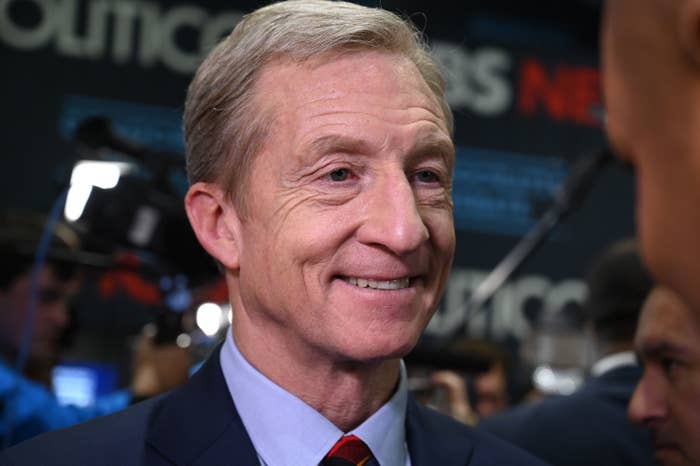
So what is Tom Steyer doing on the debate stage tonight?
He’s a truly successful money manager, a quirkily charming guy, and a climate activist for long enough to prove his sincerity. But as the debates have winnowed to people with a clear shot at being president, his plaid tie and fourth-wall stare grew jarring Tuesday.
The answer to this question has less to do with Steyer than with the Democratic National Committee, which ended the 2016 presidential cycle under siege. DNC insiders, in emails published by WikiLeaks, clearly favored Hillary Clinton, and the party’s left suspected the system had been rigged against them.
So for 2020, DNC Chair Tom Perez abandoned the committee's traditional role of, well, rigging the system and steering the party. And it instead created a system someone else could rig — if they thought about the primary process more in terms of arbitrage than persuasion.
Steyer’s professional career has been mentioned, when it’s mentioned at all, mostly in coverage of his firm Farallon’s investments in dirty energy, which would help fund climate activism. There’s been virtually no coverage of the broader sweep of his career, which — as I gather from the occasional story in Bloomberg and Institutional Investor — involved using elite connections and a great reputation to raise a huge amount of money and build a “multistrategy arbitrage operation.”
Arbitrage is the practice of taking advantage of different prices of an asset in different markets, buying in one and immediately selling in the other. In particular, Steyer learned at Goldman Sachs the practice of merger arbitrage, in which he would simultaneously buy and sell the stocks of two companies that are merging, and profit when the deal closed. Investors reportedly liked Steyer because he got great returns with relatively low-risk strategies like that one; unlike many in his generation of financiers, he didn’t get rich borrowing money and taking huge risks. He got rich studying systems carefully and exploiting the gaps.
And that’s what Steyer’s doing on that debate stage, his spokesperson circulating the press file looking like the cat who swallowed the canary. It's why moderator Wolf Blitzer is asking — aren’t we all — “Would a President Steyer use military force as a deterrent?”
Some of the candidates who aren’t there also raised and spent millions. But only Steyer exploited the DNC’s complex system, in which you need to meet percentage requirements in a series of polls to qualify for the debates. He realized that popularity in South Carolina in December and January can be bought relatively cheap — and converted into a coveted spot on the Des Moines stage. And so he essentially converted an investment in a strangely early advertising campaign in South Carolina — when he was basically alone on the air there — into poll results that got him into the debate.
Soon, the system leaves the hands of the DNC and enters (mostly) the hands of Democratic voters. You probably can’t arbitrage your way to the nomination.
But Steyer’s success marks a new stage in the collapse of the Establishment Institutions that used to control America’s political process. And as in pretty much everything else these days, a kind of financial speculation immediately filled the gap. The DNC thought it was transparently laying out a system that nobody could see as rigged. Instead, it was creating a great opportunity for a skilled arbitrageur.
CORRECTION
This story has been updated to correct the definition of merger arbitrage.
